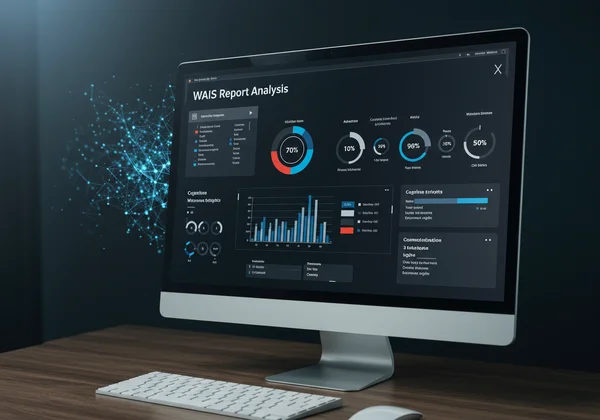WAIS Test: Scatter Analysis & Profile Interpretation for Clinical Use
The Full-Scale IQ (FSIQ) from a Wechsler Adult Intelligence Scale (WAIS) test offers a snapshot of cognitive ability, but this single number is just the book's cover. The real story lies within the patterns and variations among the scores. This is the domain of WAIS scatter analysis and profile interpretation—a process that transforms numbers into a rich narrative about an individual's unique cognitive landscape. But what is the WAIS test truly revealing when we look deeper?
This guide delves into the advanced interpretation of WAIS results, exploring how analyzing score "scatter" can unlock profound clinical insights. We will cover the methodology, its practical applications, and the ethical considerations paramount to its use. For those who already have their scores, understanding these concepts is the first step toward a deeper self-awareness, a journey that modern tools can now make more accessible than ever. Discover how to get a more personalized WAIS report analysis on our platform.
What is WAIS Scatter Analysis and Its Significance?
At its core, wais scatter analysis is the examination of the variability among the different scores obtained from a WAIS test. Instead of just focusing on the average (the FSIQ), it highlights the peaks and valleys in a person's cognitive profile. This variability can be far more informative than a single score, pointing to specific cognitive strengths and weaknesses that have real-world implications. The significance lies in its ability to generate hypotheses about an individual’s learning style, information processing, and potential underlying neurological or psychological conditions.

Understanding Index Score Discrepancies
The modern WAIS is structured around four primary Index Scores: the Verbal Comprehension Index (VCI), Perceptual Reasoning Index (PRI), Working Memory Index (WMI), and Processing Speed Index (PSI). Scatter analysis begins by comparing these scores to each other. A "flat" profile, where all four scores are relatively similar, is less common than you might think.
Often, significant differences emerge. For example, a person might have a very high VCI but a much lower PSI. This discrepancy isn't just a statistical curiosity; it suggests a specific cognitive pattern. This individual might be excellent at understanding complex verbal information and expressing ideas, but may struggle with tasks that require speed and accuracy under time pressure. Recognizing this pattern is crucial for both clinical assessment and personal development.
Subtest Level Analysis: A Deeper Dive into Variability
The next layer of analysis involves looking at the scatter among the individual subtests that make up each Index Score. An Index is an average of two or three subtests, and this average can mask important variability. For instance, a person's overall PRI score might be average, but within that index, they could have a very high score on Block Design (a measure of visual-spatial analysis) and a very low score on Figure Weights (a measure of quantitative reasoning).
This subtest variability provides a more granular understanding of a person's cognitive functioning. It allows a clinician to move from a broad statement like "average perceptual reasoning" to a more precise hypothesis, such as "strong non-verbal problem-solving skills but potential difficulty with quantitative fluid reasoning." This level of detail is where true personalization in understanding begins.
The Methodology of WAIS Profile Interpretation
Simply observing differences in scores isn't enough; wais profile interpretation is a systematic process that requires clinical expertise. Professionals use statistical methods and deep psychological knowledge to determine which patterns are meaningful and what they might suggest about an individual's cognitive architecture. This process moves beyond mere observation to informed hypothesis testing.
Identifying Statistically Significant Strengths and Weaknesses
Not every point difference between scores is meaningful. A key step is determining whether a discrepancy is statistically significant—that is, unlikely to have occurred by chance. Clinicians compare an individual's score differences to data from the standardization sample (the large, representative group of people on whom the test was normed).
Furthermore, they consider the base rate of a particular score difference in the general population. If a 15-point gap between VCI and PRI occurs in only 5% of the population, it is considered rare and likely clinically significant. This methodical approach ensures that interpretations are grounded in objective data, identifying true cognitive strengths and weaknesses rather than random fluctuations.

Common Profile Patterns and Their Potential Clinical Meanings
Over decades of research and clinical practice, certain profile patterns have been associated with specific cognitive styles or clinical conditions. For example, a profile where the VCI and PRI are significantly higher than the WMI and PSI is sometimes seen in individuals with attention-related difficulties, as working memory and processing speed are often impacted by executive functioning challenges.
It is critical to stress that these patterns are not diagnostic on their own. They are clues that must be integrated with a comprehensive evaluation, including background history, behavioral observations, and other assessment data. These patterns provide a powerful starting point for a deeper investigation by a qualified professional. For those seeking to explore your profile, our tools can help illuminate these patterns.
Clinical Applications of WAIS Profile Insights
The ultimate goal of advanced WAIS interpretation is to use the insights gained to make a positive impact on an individual's life. The clinical use of wais profile analysis extends from diagnosis to personalized guidance, offering a roadmap for intervention, support, and growth. It's about turning data into actionable steps.
Informing Differential Diagnosis and Intervention Planning
In a clinical setting, WAIS profile analysis is an invaluable tool for differential diagnosis. For example, it can help distinguish between a specific learning disability in reading (which might show a pattern of lower VCI or WMI) and a more general attention issue. The specific cognitive strengths identified can be leveraged in intervention planning. A student with a weak working memory but strong verbal comprehension could be taught to use verbal strategies to compensate.
Beyond Diagnosis: Tailoring Educational & Vocational Guidance
For many, the value of understanding wais results lies outside a clinical diagnosis. For the software engineer who is a lifelong learner, understanding that their strength lies in perceptual reasoning can affirm their career choice and guide them toward roles that leverage visual problem-solving. Conversely, identifying a relative weakness in processing speed can lead to developing strategies like time management and breaking down tasks to improve efficiency. This is where WAIS results become a tool for empowerment and strategic personal development.

Ethical Considerations and Limitations in WAIS Interpretation
With great power comes great responsibility. The interpretation of WAIS profiles must be handled with extreme care and ethical consideration. A score profile is not a definitive label of a person's worth or potential. The interpreter must consider the individual's educational background, cultural context, and emotional state during testing, as all these factors can influence performance. Over-interpreting small score differences or using patterns to rigidly categorize individuals is a misuse of this powerful psychometric assessment tool.
Enhancing WAIS Report Analysis with Modern Tools
The complexity of profile analysis has traditionally required extensive manual calculation and deep clinical experience. However, modern technology offers powerful new ways to supplement this process. Advanced tools can help identify subtle patterns and present data in a more accessible format, enhancing the wais report analysis for both professionals and individuals.
How AI Augments Pattern Recognition and Efficiency
Artificial intelligence excels at recognizing complex patterns within large datasets. When applied to WAIS scores, an AI-driven tool can instantly calculate the statistical significance of discrepancies and compare a unique profile against thousands of data points. This doesn't replace the clinician's judgment but acts as a sophisticated assistant, flagging areas of interest and performing complex calculations that would be time-consuming to do by hand. This efficiency allows the professional to focus more on the human element—the person behind the scores.
Personalized Insights: Beyond the Standard Report
For individuals seeking to understand their own results, AI can translate the complex psychometric data into clear, personalized, and actionable insights. Instead of just seeing numbers, a user can receive a narrative report that explains their cognitive strengths in plain language and offers tailored suggestions for career, education, and personal growth. If you are ready to move beyond the numbers, our AI-driven tool can help you uncover the rich story your cognitive profile has to tell.

Unlocking Deeper Insights: Your Journey with WAIS Profile Interpretation
Moving beyond the FSIQ to embrace WAIS scatter and profile analysis is essential for a deep understanding of cognitive abilities. This approach reveals the unique tapestry of strengths and weaknesses defining how we think, learn, and solve problems. While this complex field requires the expertise of a qualified professional, the journey to self-understanding is for everyone. By combining professional guidance with innovative resources like AI-powered analysis, the insights once reserved for clinical reports can now empower personal growth.
Ready to unlock the deeper story behind your WAIS scores? Learn how our AI-driven WAIS analysis platform can provide a personalized analysis, transforming your test results into a roadmap for success.
Frequently Asked Questions About WAIS Scatter & Profile Analysis
What does significant WAIS scatter indicate?
Significant WAIS scatter indicates that there is a meaningful and statistically unusual amount of variation among an individual's scores (either between Indexes or subtests). It suggests that the person's cognitive abilities are not uniform. This pattern often points to specific cognitive strengths and relative weaknesses that can be more informative than their overall IQ score.
Can WAIS profile analysis diagnose a psychological condition?
No, WAIS profile analysis alone cannot diagnose any condition. It is a tool that helps clinicians form and test hypotheses as part of a comprehensive evaluation. A pattern of scores may be associated with conditions like ADHD or learning disabilities, but a formal diagnosis requires integrating this data with clinical interviews, developmental history, and other relevant information.
How do professionals interpret complex WAIS results effectively?
Professionals use a systematic approach. They first ensure the overall results are valid, then analyze scatter at the Index and subtest levels, identifying statistically significant discrepancies. They integrate these findings with extensive knowledge of neuropsychology and the individual's personal background to form a holistic and contextually-aware understanding. You can start to understand your scores with our introductory guides.
Is the WAIS test reliable for advanced clinical assessments?
Yes, the WAIS is considered one of the gold-standard instruments for assessing adult intelligence. Its excellent psychometric properties, including high reliability and validity, make it a trustworthy tool for clinical assessments when administered and interpreted by a qualified professional who understands its nuances, including profile analysis.
What are the key limitations of interpreting WAIS profiles?
The primary limitation is the risk of over-interpretation. A score profile can be influenced by many factors beyond cognitive ability, such as anxiety, fatigue, motivation, and cultural background. A skilled clinician must consider this context and avoid using the profile to make rigid or deterministic statements about an individual's potential or pathology. The profile is a clue, not a conclusion.